
Volunteers share a joy of skiing, passion for Killington and service
By Karen D. Lorentz
For Killington regulars, the green-jacketed Killington Mountain ambassadors are a familiar presence as they interact with and help guests every day at the ski resort. This year, the ambassadors also play another significant role: they reminding people to mask-up.
In doing so, they are helping keep guests safe and to preserve the ski season.
For skiers and snowboarders new to the area, the ambassadors can make the difference between a good day and a great day. Sometimes they even save the day. Everyday they help people find their way around the mountain or reunite separated parties.
The volunteer ambassadors are passionate about the mountain and have a keen desire to help guests. They promote people having good experiences so everyone can enjoy skiing, ambassador Program Manager Peter “Pete” Duffy noted. “People are so happy to have some normalcy,” he said. “We locals might take enjoying skiing for granted this year, but enabling others to enjoy the mountain experience is more special this year. It’s one of the positives” to be able to forget the pandemic for awhile, he added.

Ambassadors at Ramshead: L to R: Mickey Cahill, Pete Duffy, Susan Cummins, and Keith Murphy who was on duty at Ramshead.
Saving the season
During this pandemic, the ambassadors’ jobs as greeters at base areas has taken on a new importance. While skiing itself is a fairly unchanged experience, other logistics have, including the way guests get tickets at some base areas. This year, Ambassadors steer arrivals to an automated kiosk or to a manned outdoor office as necessary.
Whether at base lodges, lift lines, or skiing around the mountain, ambassadors are also always on the lookout for appropriate mask use. Where masks aren’t covering mouths and noses as is required by state mandates, they make a pleasant request to mask-up followed by an appreciative thank you.
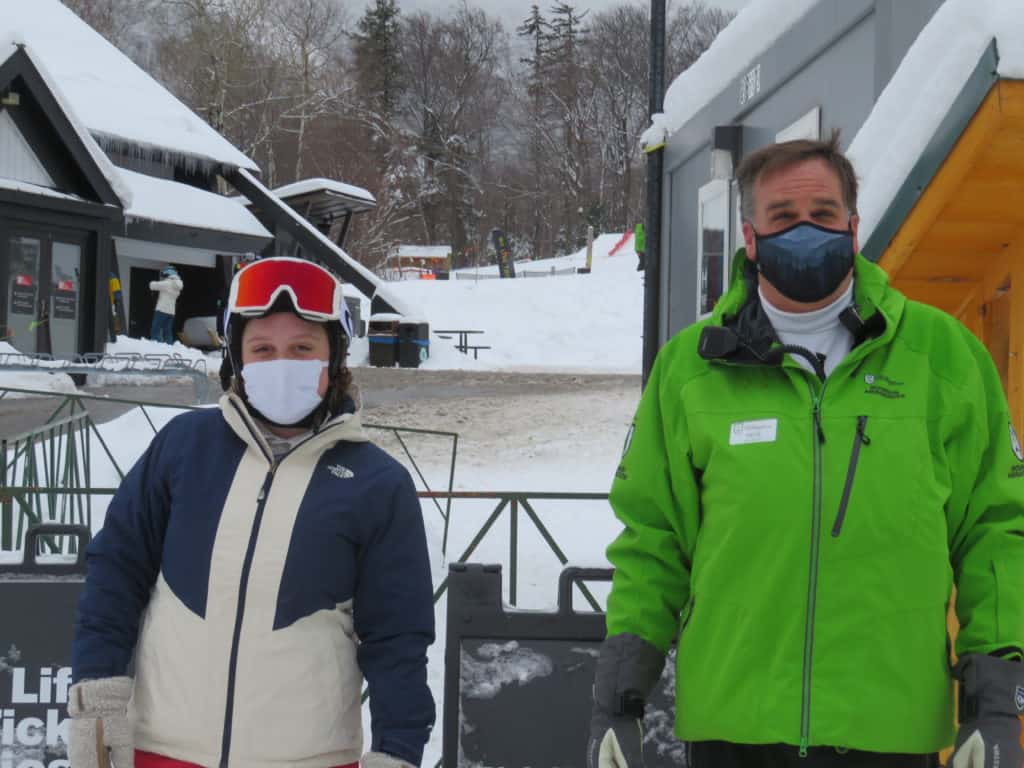
Ambassador Coordinator Shea Dunlop and program manager Pete Duffy stand together wearing masks at a base area. Sbe’s his “right-hand man.”
Why is this so important?
In addition to ensuring the measure for public health, the resort wants to save the season for everyone. Duffy noted that it’s very understandable for skiers and riders to need the occasional reminder, as it is easy to forget to mask-up when you reach the bottom. When skiing/riding down a trail, masks are not required.
Admittedly it’s a nuisance to cover one’s nose if the temps are such that goggles fog up, but that’s a small price to pay for being able to enjoy the mountain. Better to mask as required than to risk the state shutting down the ski areas and affect the ski season for all.
That would include not just the ski resorts but also all the businesses that service skiers and riders — local restaurants, shops, lodges and inns, gas stations — and their staff.
Duffy said 98% of reminders net a quick compliance or even an apology. Those who rebel acquiesce after the explanation that state regulations require the resort to keep people safe so there can be a ski season.
Many guests also thank the ambassadors for their reminders to keep the area safe saying that it make them feel more comfortable to ski and ride themselves.
Reminders to mask-up are just a small part of what ambassadors do, however.
They dispense information, ranging from how to navigate the seven peaks of Killington and Pico to tips on restaurants and shops where a guest might find something they need. In this way they also serve as “good-will ambassadors” to the business community, a significant role when you think of the thousands of people who visit Killington each winter.
They greet people in the morning, answer questions, and help visitors find their way back to starting points at the end of the day. Throughout the day, they ski around assigned mountain areas and answer questions just as their bright green jackets invite with “May I Help You?” printed boldly on the back.
Often, ambassadors are asked for advice on where to eat or where to shop for a particular item in town. Other times they advise on new Covid protocols and changes, including what’s open.
Ambassadors also assist other departments as needed.
The sweet perk is skiing until it’s time to assist the ski patrol with the end-of-the-day sweep — which, on occasion, can mean skiing during a brilliant sunset. But, Duffy noted, ambassadors do all these tasks in all kinds of weather, including extreme cold, wind, snow, and rain. They are usually done by 4:30 or 5 p.m. so it’s a long day but it’s one most Ambassadors enjoy immensely.
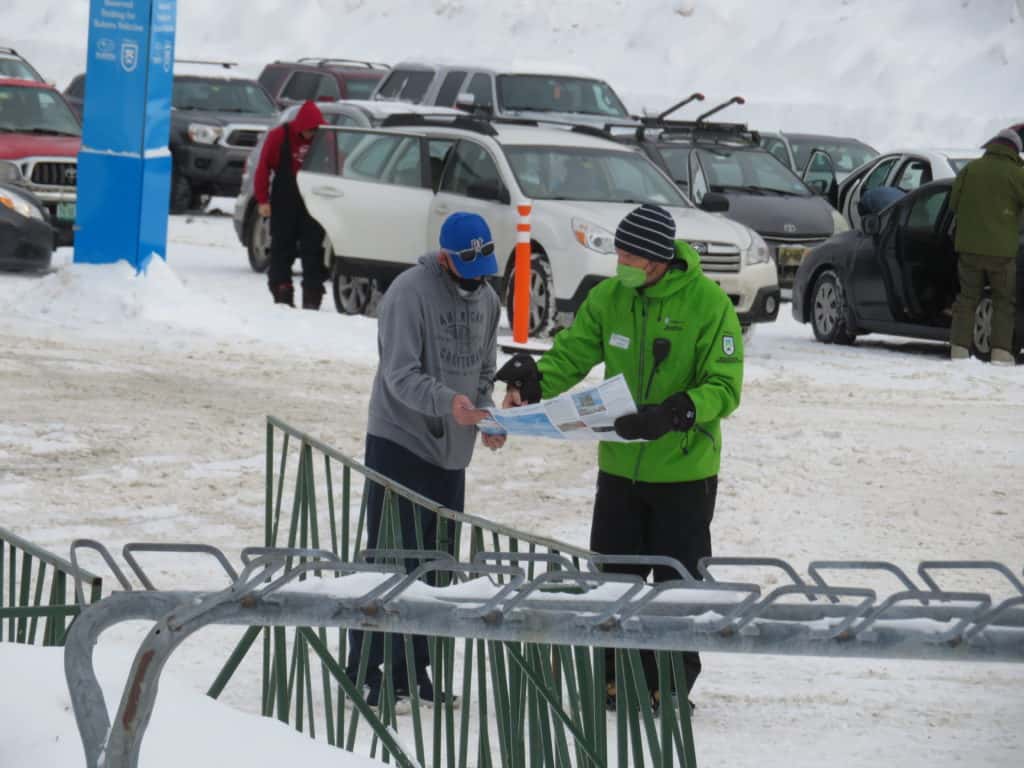
(Above) Ambassador Keith Murphy helps a guest arriving at Ramshead with finding his way around the resort. (Right) The automated ticket kiosk at Ramshead.
Changes this year
The pandemic-induced changes go far beyond masking and distancing reminders. During normal times, ambassadors gave free “Meet the Mountains” tours to help orient people to the massive resort, greeted arriving bus groups, took photographs of groups, and helped at the Grand Hotel and with events.
Now these services are on hold. Guests are encouraged to familiarize themselves using the resort’s website or new app which is free to download. But if they don’t, the ambassadors, who are briefed daily on updates at pre-mountain opening meetings, are there to assist.
Dining inside resort base lodges is one experience that has changed significantly and ambassadors often help guests understand: at entry, resort employees will scan the visitor’s ticket or pass (for contact tracing reasons) and give them a time limit for indoor seatings.
Ambassadors are certainly answering more questions this season. However, they are happy to do so because not knowing causes inconveniences and they want to ameliorate them to the extent possible so guests don’t get frustrated. Their purpose, to “help ensure a good experience and the joy of the slopes,” hasn’t changed.
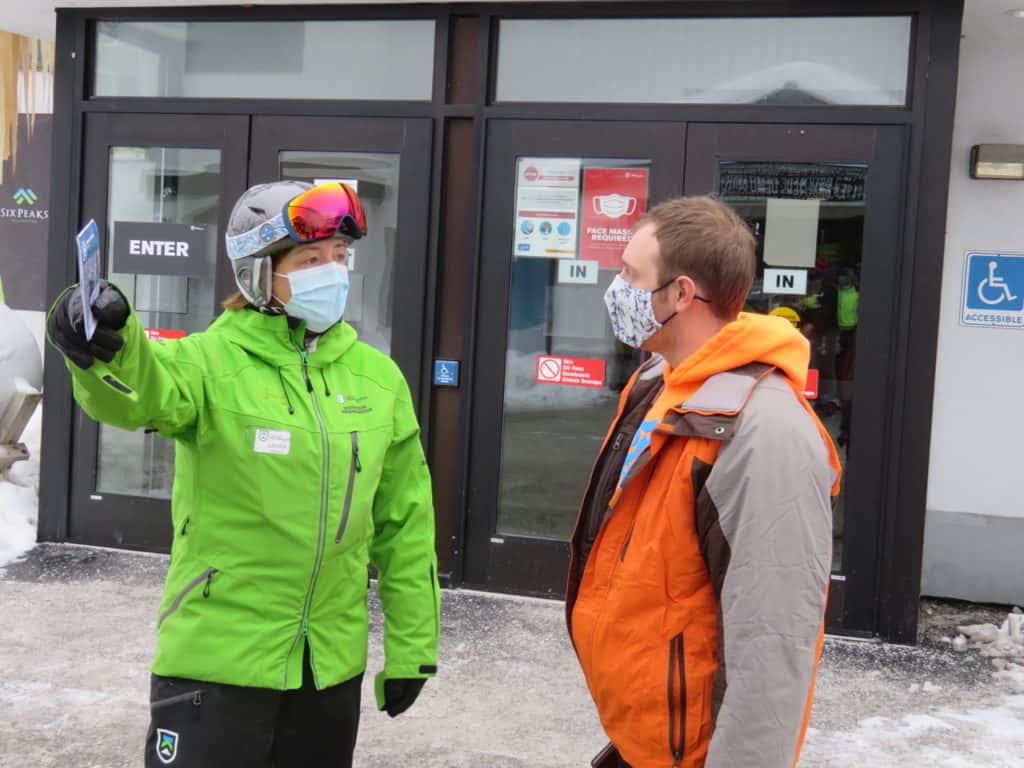
(Left) Ambassador Laura Calleri helps guests at Snowshed.
First hand account
I witnessed that helpfulness on Feb. 4 as Duffy introduced me to the greeters at Ramshead and Snowshed and explained the places where people get tickets.
Then I had the fun of being shown around by ambassadors Susan Cummins and Mike “Mickey” Cahill. Not only did they point out changes and answer my umpteen questions, I saw them answer others’ questions like “Is the Stash open?”
“Yes, opened 15 minutes ago” the ambassadors answered, which received a grateful “Thanks” from a Peace Park boarder. Later, another freestyler asked the same question and got “opened an hour ago.” I’m sure both had smart phones, so they could have checked, but the answer from the ambassador in green made their days easier – and better as they got to enjoy the Stash’s season debut.
I experienced much new to me, too: from the third Snowdon tunnel to a tour through the impressive Peace Park. Along the way I picked up info like how many tunnels Killington has (there are eight).
But it wasn’t just the education that impressed me — it was experiencing how much has changed and just how helpful ambassadors really are to so many skiers and riders. It was the way they interacted with people and even thanked them for masking up that made me realize how seriously they take their jobs.
At the same time they graciously and warmly showed me around and they shared their insights as to the joys of being Ambassadors.
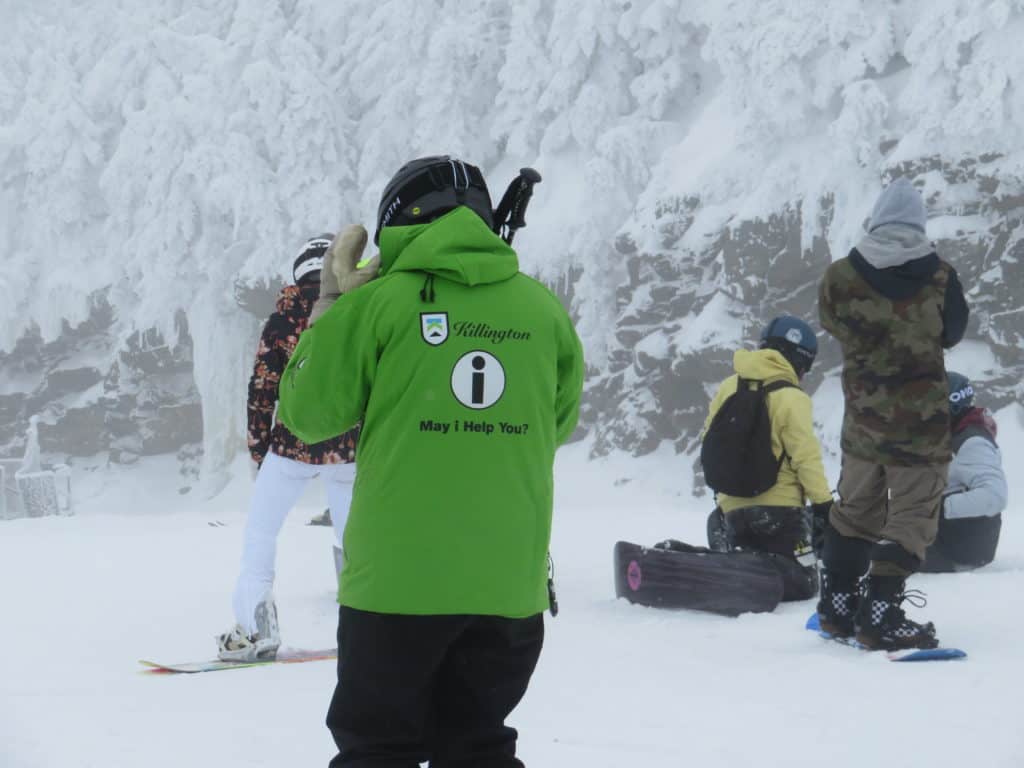
Stories that resonate and inspire
Mike Cahill shared that he was a little lost when he had to retire from being a New York state trooper at the mandatory age of 60. Noting he loves skiing Killington and helping people enjoy the mountain, he told me he decided to become an Ambassador. “It helped me fill a void in my life after I retired. I enjoy the camaraderie within the group of outstanding people who share the same goals,” he said.
Cahill hails from Middletown, New York, but resides in Killington from October to May. He said one of his most memorable experiences was meeting and helping a military man. “One night while clearing the mountain at the end of the day, I came upon a young man who was skiing down from the top of K-1 with his girlfriend. She was struggling and repeatedly falling. While waiting for the young lady, he told me that he was in the military and had just returned from a deployment. He asked that I thank Killington for how well they treated military personnel. Then he said that it was his idea to bring the young lady who was a beginner to the top at the end of the day,” Cahill recounted. “As it was getting dark, I advised him that if he wanted to stay in her good graces that he recommend to her she get into a ski patrol sled and have them transport her to the bottom of the mountain. He did that. Two days later he could not thank me enough.”
Cahill is not the only one to have helped with young love.
One of Duffy’s favorite ways of helping is with marriage proposals! When asked to assist, he takes dyed water and writes the wedding proposal on the snow under a chairlift, which adds to the delight of more than just the happy couple, he noted.
On a lift ride, Susan Cummins shared some insights about becoming an ambassador when her youngest child left for college eight seasons ago. “Being an ambassador allows me to be me. The green jacket is my license to greet people, inquire about their day and offer help. The green jacket is widely recognized by guests as a friendly face willing to help and guide. Through the program, I have generated some wonderful friendships — some so close they have come to my family events like weddings and holidays.”
Asked her favorite ambassador experience, she said, “On weekends, often I am stationed at the Grand Hotel [not this year though], greeting families as they enter the buffet. Many are return visitors and remember me. I get to catch up with parents and learn about what the children have done since last season. Invariably, the children ask me where they should ski. The best is when the next morning they look for me to share how terrific their day skiing was. I love their faces!”
Their sincere appreciation for the connections that being an ambassador has engendered and finding happiness in volunteering resonates with many and encourages them to join the program. The “extended family” feeling is real among the Ambassadors and it’s one many have been craving during these isolating times (it’s even made me want to become an Ambassador).
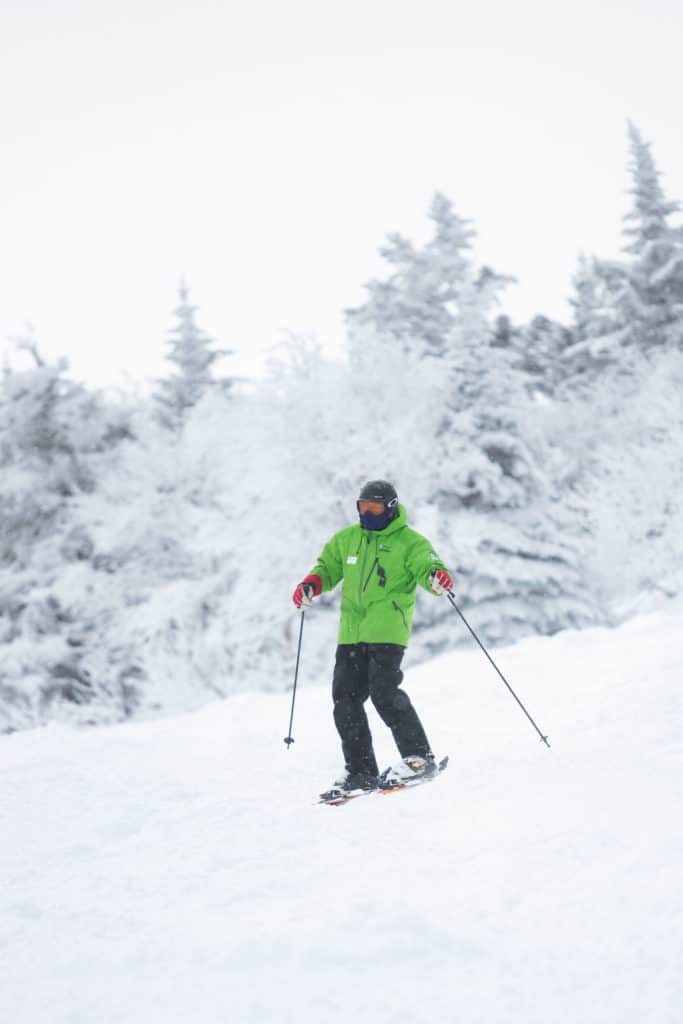
How it all began
The Killington Ambassador Program began in the 1962–63 season with volunteers deemed to have “an acute case of Killingtonitis.” In love with skiing the mountain, they became good-will troubadours, singing the praises of Killington to ski clubs and others in their home states and distributing “tons of brochures” throughout the East. They also could be found helping by parking cars, directing traffic, officiating at races, serving hamburgers, relieving ski-shop cashiers, and doing other helpful work to ensure the success of the young ski area.
Eventually the need for ambassadors faded as the area hired more people, and the group dwindled to six. However, the Skier Courtesy Ambassador group was organized in the 1980s to promote skiing in control and courtesy on the slopes. At that time the on-hill duties included mostly checking on guests on weekends.
In the 1990s, the program grew again to 80 ambassadors under director Janis Albrecht. Duties were expanded to include more “helping functions” and even conducting customer surveys and acting as a source of feedback on how Killington was doing for its guests.
When John “Grizz” Puchalski became the first snowboarding ambassador in 1994, he began handing out candy to guests and convincing management that the volunteers should be all over the mountain and serving midweek, not just weekends. He became the program director for the 1997–98 season and expanded duties to include other seasons and increased the number of volunteers to 275 so as to accommodate the needs of the mountain. (The summer assistance by ambassadors became a new summer host program in 2016.)
Duffy, an ambassador since 2007, became the program’s manager in 2016 and operates the program out of offices at the Killington Medical Clinic. It’s there that he typically gives morning briefings (7:20 a.m. weekends, 8:20 a.m. weekdays) to those on duty. This year, the briefing location changed to the Ramshead dining area due to the need to be physically distanced.
At the briefings Duffy imparts information that helps the ambassadors answer guest questions that day — including snowmaking, grooming, and other updates along with safety and other tips.
His job also includes communicating and working with other departments throughout the resort.
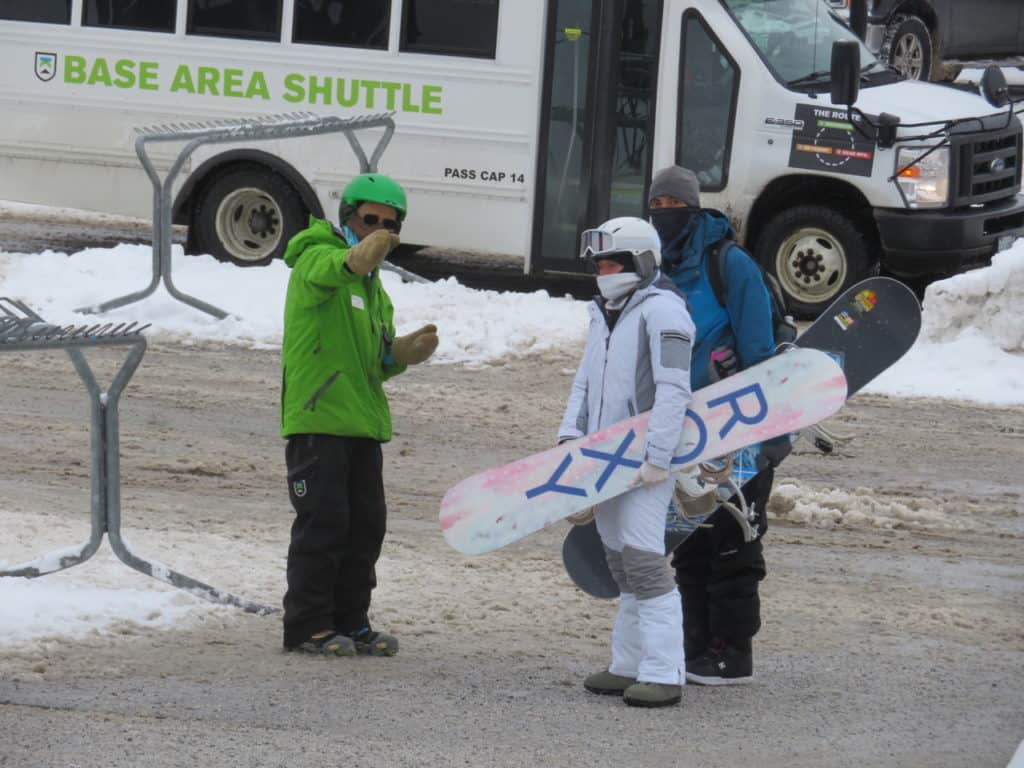
by Karen Lorentz
Becoming an ambassador
Duffy first interviews men and women ages 18 and up, focusing on whether the candidate would be “a good fit” and able to provide the required 21 days of service. This year, he gave past ambassadors the option to not serve, but 180 out of 250 volunteers chose to return, due in large part to retirees and others able to live in Vermont for the season. He also had 18 new people sign up for their first season.
“We have ambassadors who ski all around the world, and we have yet to find a place that has more people serving as ambassadors or hosts,” Duffy said of his delight and pride in the program.
Echoing his appreciation for the work of the Ambassadors, Mike Solimano, president and general manager of Killington Resort and Pico Mountain, noted, “Volunteers of Killington’s ambassador program are a big part of the guest experience at The Beast. As the largest ski resort in the East, there’s a lot of ground to cover and our ambassadors are a passionate group that offer helpful information and assistance to those around the mountain.”
Now in his 15th season, Pete Duffy has had many wonderful experiences, including special emails from Mikaela Shiffrin thanking him and the Ambassadors for their many kindnesses to her family during the World Cup. When asked his favorite memory, Duffy wrote:
“I think being involved with the World Cup is at the top of my list. I stay in touch with members of Mikaela’s family as well as her manager Kilian Albrecht and always enjoy doing whatever I can to make their visits here for the World Cup as memorable as possible.
“Every year I get asked to escort Mikaela around the resort: to and from press conference, races, the doping room etc. It’s a job I take very seriously but am honored to do. She is a very normal and down to earth person who just so happens to be one of the best ski racers in the world but hasn’t let that go to her head.
“After the Saturday race of the last World Cup, I was asked to drive Mikaela back to the house where she and her coaches were staying. It was one of the few times that I enjoyed being stuck in traffic on the access road because we spent the time chatting about many different things,” he said.





